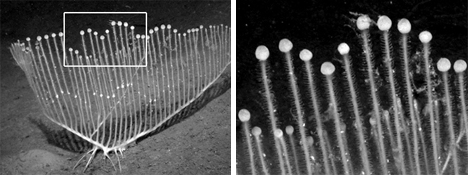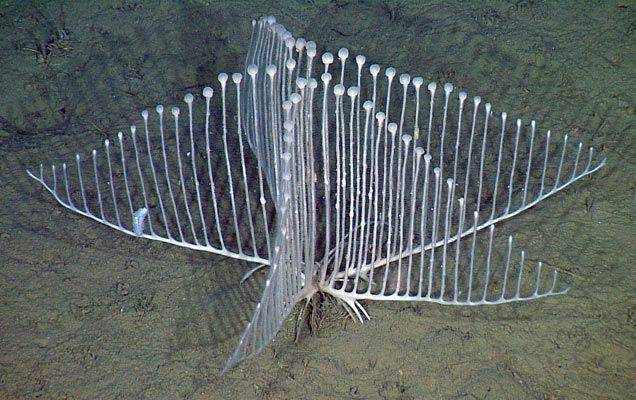Porifera
Author Mia Yockey
Co-Author Antony Rich
The phyla porifera though said to be a group of simple organisms, is actually quite complex, and all-around fascinating. The name Porifera means “pore-bearing animal”, an example of this is the mysterious sea sponge. Majority of them are filter feeders meaning they filter feed through the pores of on their skin. Majority of Sponges eat algae and plankton, though there are a few Carnivorous sponges out there too. This brings us to our organism, the harp sponge a newly discovered member of the Porifera phyla, and we will be diving into the physiology of this unique creature. This means we will be looking at its physical aspects and how they work and help it survive.
http://www.realmonstrosities.com/2012/11/harp-sponge.html
MBARI, Real monstrosities,September 11th, 2012. This image shows the depth range of the harp sponge
It is a carnivorous sponge that lives in the deep sea off the coast of California. They are a typically found isolated and alone, as opposed to most sponges which are found close together. This could be due to the environment, since most sponges live in coral reefs were there isn’t much space and a variety of life. While in the west coast there’s a lot of open space for the harp sponge to live. The isolation could also means little competition for prey, as I stated above, the harp sponge isn’t a filter feeder, so it uses the tentacles from its body to ensnare fish and crustaceans. Then once it has it’s prey, it then proceeds to slowly digest it. Since there is no teeth or venom involved, the food is put in a small opening in the middle of the sponge, so they prey is still alive as it’s being digested, yikes!
For another bodily function , lets discuss the terminals, which are the white sphere you see on the spines of the harp sponge, these are uses for reproduction. They contain sperm so when released the sperm will flow with the current and attach to another harp sponge. Making the harp sponge asexual much like the others of its phyla. The sponges catch the sperm exactly like they do prey using their branches to catch it putting it into their system.
Teresa Carey – Meilina Dalit – Nancy Barr
Now on to some other functions of the harp sponge: the gas exchange, circulation and excretion. The reason these functions are put into one group is because they are accomplished by using the diffusion of Ocean water in order to operate. This is a benefit of being an organism like the sponge, that is rooted to the sea floor, the Ocean can do some of your work for you ! Whether a sponge is carnivorous or a filter-feeder and no matter what environment it may live in, the porifera phyla has some pretty interesting organisms in it. Life in the Sea is amazing in general.
http://stuffpoint.com/animal-lovers/image/176908/harp-sponge-picture/ An image of the harp to show what the organism looks like. From Animal lovers
Teresa Carey – Meilina Dalit – Nancy Barr
A cite discussing the discovery of the harp sponge
https://www.youtube.com/watch?v=VC3tAtXda
(Harp sponge video by Monterey Bay research institution)
Showing the finding of the harp sponge
Cite on the harp sponge and its discovery and attributes


